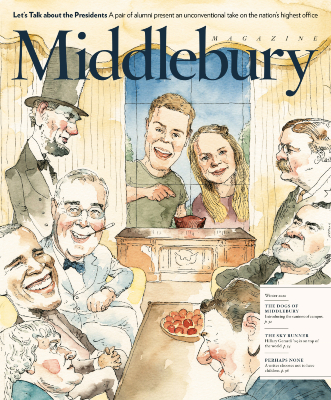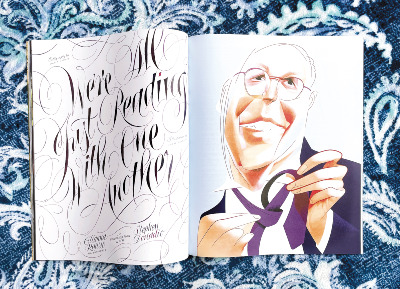
Did COVID-19 Kill Middlebury Magazine?
This is a story about a magazine, a printed periodical that was published for 93 years, every three months. Until it wasn’t.
Did COVID kill it?
No, but it delivered a hell of a jolt to the publication, sidelining it for three years, during which time, I and my colleagues took the opportunity to rethink—and, potentially, redefine—just what a magazine should be.
This is that story.
By Matt Jennings
March 2020
If you’ve ever doubted the fallibility of human memory, I suggest you use the events of just the past three years to test your ability to accurately recall even broadly defined details of your lived experience.
When, exactly, did COVID-19 start to shut down everyday life in the United States?
How long were we quarantined at home?
For how long did we sanitize our groceries with Clorox wipes?
When did we decide to pause publication of the magazine I’ve edited for the past several decades? And when did we think we’d return to circulation?
A pair of emails sent to me on March 6 and March 7 of 2020 illuminate the fallibility of my own memory, so much so that I literally LOLed when I read them recently.
You see, it’s been my assumption that by the beginning of March, we were quite aware of the potential disruption this threatening virus could have on our lives and work. But that’s not remotely true.
Though Middlebury had suspended its Study Abroad program in China, where the outbreak began, at the end of January, requiring our students to return home, a look back at the timeline of the disease’s spread reveals a certain sluggishness in our collective awareness of what was occurring domestically.
By mid-February, the U.S. Centers for Disease Control and Prevention reported 15(!) cases of COVID-19 in all of the United States. It wasn’t until March 11 that the World Health organization declared COVID-19 a pandemic.
So I guess it should come as no surprise that on March 6, when I received our spring issue advertising report from our sales rep, my one-word email response was, “Thanks!”
There was no mention of a global health crisis potentially upending our work.
The next day, I received a bit of fan mail from a reader and longtime friend. He was gushing with praise for our winter issue—“The magazine continues to shine and engage. Great stories this issue.”—and it was only toward the end of his missive did he mention the coronavirus, and even then lamenting how the health threat was prohibiting him from traveling to Asia for a long-planned vacation.
An examination of my received and sent emails for the following week or so reveal continued planning for the upcoming spring issue. Nestled between alerts from the New York Times about the domestic spread of the virus and an email from my uncle, a New York City pulmonologist, describing in great (and scary) detail what this virus could be, was an email containing a memo written by me on March 16 and sent to our editorial staff. It was titled “COVID and the Spring issue.”
When I opened this document recently, I chuckled again at how obtuse or naive my past self seemed. The memo began with this line: “Timing: Currently scheduled to print around April 24, I’d recommend shifting a couple of weeks and printing in early May.” The rest of the memo outlined the stories we’d be ripping up and replacing with timely COVID-related pieces (for instance, an essay from a student who had returned from China in late January).
Two days later, on March 18, I sent another email and memo. We weren’t going to be able to print and mail the spring issue. I then let our sales rep know that we’d offer advertisers a 20-percent discount when we returned to print—in the summer.
Over the subsequent months and years(!), there were many factors that contributed to the sidelining of the print edition of the magazine: paper shortages, postal service disruptions, and, honestly, a world that was so fast-changing, the idea of publishing a quarterly periodical seemed like folly, either out of touch or woefully out of date.
But the primary reason that kept us out of the printing game for so long was one thing: budget.
The day I notified our team that we would not be printing a spring issue, Middlebury College sent its students home—at first for an extended spring break and then for the rest of the semester. This decision had an immediate budget implication for the remaining three-and-a-half months of the fiscal year. Room-and-board for the departed students would be refunded on a pro-rated basis. The residential summer graduate programs subsequently canceled in-person learning, meaning lowered fees and no room- and-board revenue. And the institution was just beginning to grapple with additional infrastructure costs relating to the virus.
I explained this all in a post on our digital magazine site: Why We’re Not Printing the Spring Issue.
What I outlined that day would remain true for the next three years. This was not an end to the print edition of the magazine. (I was assured by my boss and administrative leadership at Middlebury that this statement was true.) And in the interim, we would not succumb to what I strongly feel is magazine malpractice: We would not be designing a magazine as if we were printing it, limiting ourselves to page counts and design technology that does not align with a digital reader’s preferred experience—and then posting a “flip-book” online. This was not going to happen.
So, what did we do? And why did it take us so long, longer than I had imagined, to return to print?
That’s the rest of the story.
MAY 2021
“I am so very sad not to hold a paper copy, seeing it over and over on a table, easily revisited, bookmarked, enjoyed, sitting anywhere but at this computer. Please tell me we will eventually return to a paper copy magazine.”
I received this emailed comment from a recipient of my monthly e-newsletter “From the Editor’s Desk” a little more than a year after we paused our print edition.
During the intervening months, we had developed a suite of digital communications tools and efforts to allow us to “continue pursuing, reporting, and publishing stories,” as I had promised, and, most importantly, maintaining an active relationship with our readers.
The first edition of my e-newsletter (originally published biweekly, before moving to monthly after a year) was immediately embraced by our readers; in the first hours after Issue No. 1 hit inboxes, I received more than 100 personal replies expressing support and gratitude for the effort. Our editorial approach to digital publishing was capitalizing on the fluidity of the medium—videos, podcasts, recommendations of other Middlebury-related reading—and the immediacy of the Internet.
And we began to receive flattering, industry-wide coverage of our efforts. I was interviewed for a higher ed podcast that offered to take listeners “inside Middlebury Magazine’s digital pivot.” That fall, a reporter from the website Inside Higher Ed reached out, wanting to talk about our digital strategy and the future of the magazine. (The story “Alumni Magazines Find Their Digital Footing” ran the following February.)
Yet.
Emails like that missive in May 2021 began to ping my inbox more frequently. With each e-newsletter send, I could count on a healthy reply from readers offering thoughts (and appreciation) for the digital stories, but more and more frequently asking, “When will we start getting a print magazine again?”
Perhaps my favorite line from any email to me was this one: “You guys do a great job with ‘From the Editor’s Desk,’ but more and more I want the sensory, olfactory, tactile, visual, artistic, integrated, passionate, eclectic, lush experience of the Middlebury Magazine.”
Internally, we were feeling the itch, too. I continued to reiterate that a pause on printing was just that, a pause—reassuring email writers and making sure I spoke about an inevitable return to print during every interview I did— and as 2021 began to draw to a close, there was movement.
Budget remained a primary obstacle. Although students had largely returned to campus that fall, COVID-related budget expenditures were still having a significant impact on the institution’s operating expenses, and within our department, paper, printing, and postage remained high-ticket items. The most direct way for us to not overspend our reduced budget was to further delay a return of the printed magazine. But things were changing.
It’s worth noting that institutional support for eventually returning to print never waned during the years that production was paused, at least as far as I know. Middlebury Magazine—specifically, the print edition—has long been seen as a vital means of connection and affinity between our readers and the institution. Reader surveys over the years have shown this, as has engagement (letters to the editor, voluminous class notes) with the magazine. And it’s been my experience that successive administrators at the institution have understood and valued this relationship, so much so that the president of Middlebury, Laurie Patton, began to ask me, over time: “When’s the print magazine coming back?”
As these voices of support grew louder and more frequent—the leadership of the Middlebury Alumni Association also began to push for a return to print—we began to have internal discussions of just how we could end our printing hiatus. And here’s where I wish I could share a magical solution that could be applicable to others who might find them- selves in similar positions. But there really isn’t one, other than organizational determination. While we did manage to reclaim some of the existing budget that had been cut, it was not nearly enough to cover all of our soon-to-be expenses. All I can say is that my boss, Vice President of Communications David Gibson, told me, “The magazine has born the burden of our necessary budget cuts long enough.” He was prepared to cut spending elsewhere in the Communications budget to prioritize a printed magazine.
So, that fall of 2021, I sent a succinct email to our design partners at Pentagram in Austin, Texas: “Are you up for creating a new magazine? Have received the green light to return to print … starting with the Spring 2022 issue. I want to take advantage of the hiatus to return with a reconceived, redesigned Middlebury Magazine. What do you think?”
The answer came back quickly: “Well, hell yeah, Matt.”
MAY 2023
During our hiatus, we embraced the luxury of time—time to figure out what a digital magazine and newsletter could do best, and time to reflect on what we missed most about print while allowing ourselves to dream about what an optimal experience with a print magazine could be.
My initial plan to debut the new Middlebury Magazine in the spring of 2022 was, well, a bit naïve, once again; it would be another year before readers would be holding a printed issue in their hands. This was partially due to circumstances outside of our control (at the time, our paper was scarce enough that our broker required many months lead time to order necessary rolls, and we wanted to make sure we had paper on hand for a second issue); and as we examined our budget at the end of FY22, it made more sense to move our launch into the following fiscal year.
But there was also this: Creating essentially a new magazine, having not exercised those specific creative muscles for a period of time, turned out to be quite difficult and time consuming. (Words of wisdom and encouragement from my boss, a former magazine veteran with many prestigious awards to his name, helped: “You’re basically running a startup while also holding down a full-time job. And it’s all going to be worth it.”)
It took us months to realize our vision—crafting a magazine experience unlike anything we had offered before, while still maintaining our core identity—months that saw a continued increase in the volume of comments (letters, emails, phone calls, chats on the street) asking, beseeching, “Whither print?”
And then last spring, the web presses at our printer rolled with a reconceived magazine from Middlebury. It’s titled Midd now; an embrace of an idea we weren’t quite ready for when we last redesigned in 2012. The new magazine is meant to be savored, rather than scanned and immediately recycled. Deeply reported stories are both current and freed from the immediate news cycle. We introduced a standing department for contemplative essays (at least three essays per issue), introduced playful art and more storytelling in class notes, and provided more room for expansive photo essays and visual storytelling that only ink on paper can provide.
And we intentionally are pushing past previous page- or word-count barriers; our relaunch issue features a 7,500-word conversation between an alumna and a former professor of hers, a conversation that began in late 2019 and concluded a month before we printed. It was originally scheduled to run at half that length, if that, in the spring of 2020, the issue that never was.
“Keep up the conversation,” I advised our writer then. “This is a piece that is made for print. We will hold it until the print magazine returns.”
We waited three years to reveal this story, a story that wouldn’t be what it is had we not waited that long.
Of all the letters to the editor following publication—of which there were many— this piece was far and away the most commented upon. Wrote one reader, “So, so thrilled to get the print version in my mailbox! It’s sitting on my desk now next to my laptop, and I read pages of it throughout the day as a break from work. I was an English major at Middlebury and love how tangible it is to read a printed book or magazine. The interviews with Stephen Donadio spoke to me, and I couldn’t put the magazine down.”
Matt Jennings is editorial director at Middlebury College and editor of Midd magazine. The son of a now-retired journalism professor, he is, at heart, a storyteller and obsessed consumer of stories told and written, crafted long and short. Connect via jennings@pagesthemagazine.com.




